Case Study Analysis: Quality and Safety in Bundaberg Hospital Nursing
VerifiedAdded on 2022/10/02
|7
|1615
|21
Report
AI Summary
This report provides a critical analysis of the Bundaberg Hospital case study, examining the failures in quality and safety within the nursing context. The analysis focuses on the actions of Dr. Jayant Patel and the hospital's organizational culture. The report highlights the lack of proper credentialing, inadequate incident reporting, and failure to address complaints, which contributed to patient harm. Strategies to improve quality and safety, such as credentialing, incident reporting, benchmarking, and complaint management, are discussed. The role of organizational culture, including whistleblowing and error reporting, is also explored. The report emphasizes the need for a cooperative organizational culture that prioritizes patient safety and addresses errors promptly. The analysis concludes by underscoring the importance of strict actions when healthcare faults are identified to protect patient health and prevent future errors.
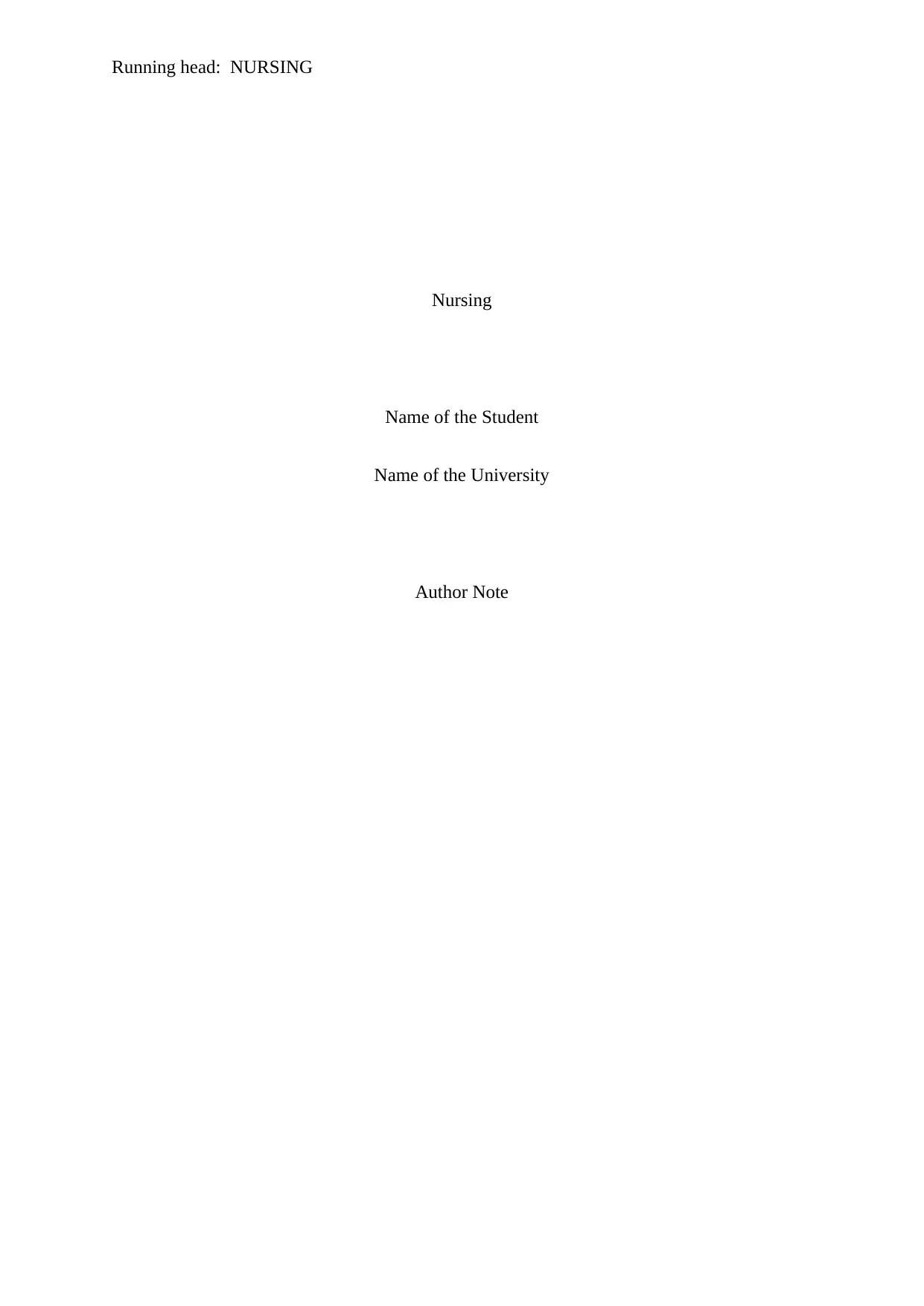
Running head: NURSING
Nursing
Name of the Student
Name of the University
Author Note
Nursing
Name of the Student
Name of the University
Author Note
Paraphrase This Document
Need a fresh take? Get an instant paraphrase of this document with our AI Paraphraser
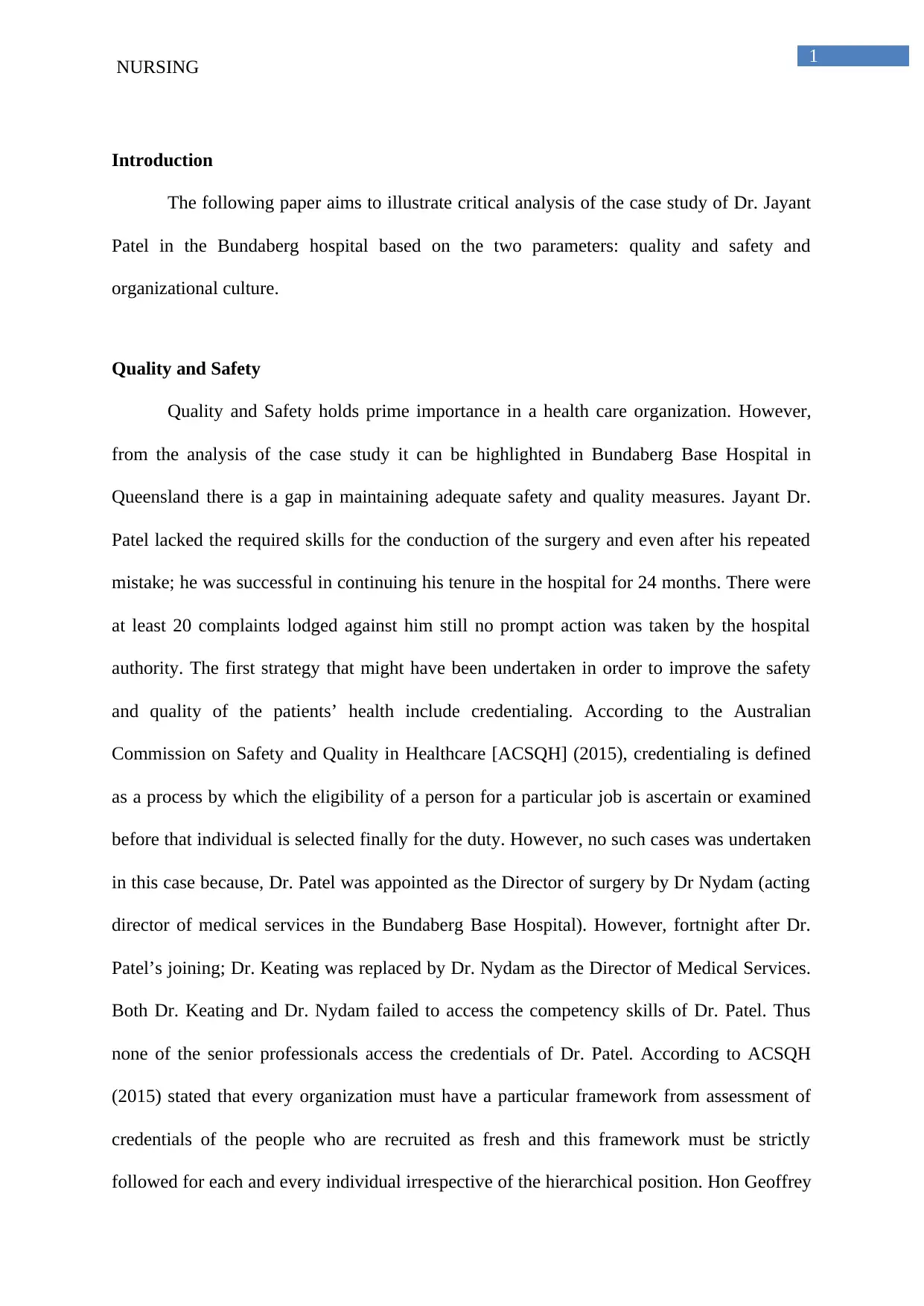
1
NURSING
Introduction
The following paper aims to illustrate critical analysis of the case study of Dr. Jayant
Patel in the Bundaberg hospital based on the two parameters: quality and safety and
organizational culture.
Quality and Safety
Quality and Safety holds prime importance in a health care organization. However,
from the analysis of the case study it can be highlighted in Bundaberg Base Hospital in
Queensland there is a gap in maintaining adequate safety and quality measures. Jayant Dr.
Patel lacked the required skills for the conduction of the surgery and even after his repeated
mistake; he was successful in continuing his tenure in the hospital for 24 months. There were
at least 20 complaints lodged against him still no prompt action was taken by the hospital
authority. The first strategy that might have been undertaken in order to improve the safety
and quality of the patients’ health include credentialing. According to the Australian
Commission on Safety and Quality in Healthcare [ACSQH] (2015), credentialing is defined
as a process by which the eligibility of a person for a particular job is ascertain or examined
before that individual is selected finally for the duty. However, no such cases was undertaken
in this case because, Dr. Patel was appointed as the Director of surgery by Dr Nydam (acting
director of medical services in the Bundaberg Base Hospital). However, fortnight after Dr.
Patel’s joining; Dr. Keating was replaced by Dr. Nydam as the Director of Medical Services.
Both Dr. Keating and Dr. Nydam failed to access the competency skills of Dr. Patel. Thus
none of the senior professionals access the credentials of Dr. Patel. According to ACSQH
(2015) stated that every organization must have a particular framework from assessment of
credentials of the people who are recruited as fresh and this framework must be strictly
followed for each and every individual irrespective of the hierarchical position. Hon Geoffrey
NURSING
Introduction
The following paper aims to illustrate critical analysis of the case study of Dr. Jayant
Patel in the Bundaberg hospital based on the two parameters: quality and safety and
organizational culture.
Quality and Safety
Quality and Safety holds prime importance in a health care organization. However,
from the analysis of the case study it can be highlighted in Bundaberg Base Hospital in
Queensland there is a gap in maintaining adequate safety and quality measures. Jayant Dr.
Patel lacked the required skills for the conduction of the surgery and even after his repeated
mistake; he was successful in continuing his tenure in the hospital for 24 months. There were
at least 20 complaints lodged against him still no prompt action was taken by the hospital
authority. The first strategy that might have been undertaken in order to improve the safety
and quality of the patients’ health include credentialing. According to the Australian
Commission on Safety and Quality in Healthcare [ACSQH] (2015), credentialing is defined
as a process by which the eligibility of a person for a particular job is ascertain or examined
before that individual is selected finally for the duty. However, no such cases was undertaken
in this case because, Dr. Patel was appointed as the Director of surgery by Dr Nydam (acting
director of medical services in the Bundaberg Base Hospital). However, fortnight after Dr.
Patel’s joining; Dr. Keating was replaced by Dr. Nydam as the Director of Medical Services.
Both Dr. Keating and Dr. Nydam failed to access the competency skills of Dr. Patel. Thus
none of the senior professionals access the credentials of Dr. Patel. According to ACSQH
(2015) stated that every organization must have a particular framework from assessment of
credentials of the people who are recruited as fresh and this framework must be strictly
followed for each and every individual irrespective of the hierarchical position. Hon Geoffrey
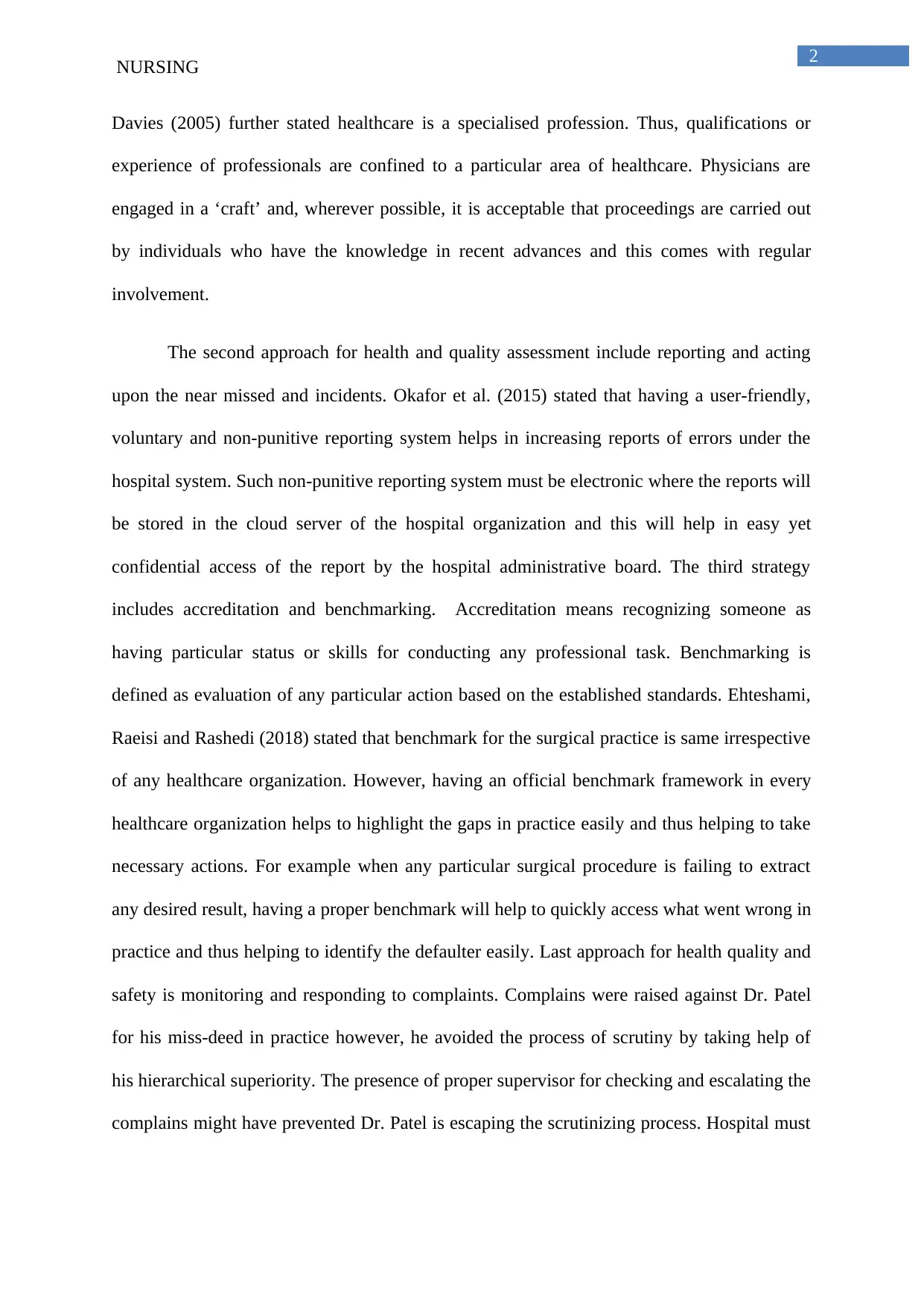
2
NURSING
Davies (2005) further stated healthcare is a specialised profession. Thus, qualifications or
experience of professionals are confined to a particular area of healthcare. Physicians are
engaged in a ‘craft’ and, wherever possible, it is acceptable that proceedings are carried out
by individuals who have the knowledge in recent advances and this comes with regular
involvement.
The second approach for health and quality assessment include reporting and acting
upon the near missed and incidents. Okafor et al. (2015) stated that having a user-friendly,
voluntary and non-punitive reporting system helps in increasing reports of errors under the
hospital system. Such non-punitive reporting system must be electronic where the reports will
be stored in the cloud server of the hospital organization and this will help in easy yet
confidential access of the report by the hospital administrative board. The third strategy
includes accreditation and benchmarking. Accreditation means recognizing someone as
having particular status or skills for conducting any professional task. Benchmarking is
defined as evaluation of any particular action based on the established standards. Ehteshami,
Raeisi and Rashedi (2018) stated that benchmark for the surgical practice is same irrespective
of any healthcare organization. However, having an official benchmark framework in every
healthcare organization helps to highlight the gaps in practice easily and thus helping to take
necessary actions. For example when any particular surgical procedure is failing to extract
any desired result, having a proper benchmark will help to quickly access what went wrong in
practice and thus helping to identify the defaulter easily. Last approach for health quality and
safety is monitoring and responding to complaints. Complains were raised against Dr. Patel
for his miss-deed in practice however, he avoided the process of scrutiny by taking help of
his hierarchical superiority. The presence of proper supervisor for checking and escalating the
complains might have prevented Dr. Patel is escaping the scrutinizing process. Hospital must
NURSING
Davies (2005) further stated healthcare is a specialised profession. Thus, qualifications or
experience of professionals are confined to a particular area of healthcare. Physicians are
engaged in a ‘craft’ and, wherever possible, it is acceptable that proceedings are carried out
by individuals who have the knowledge in recent advances and this comes with regular
involvement.
The second approach for health and quality assessment include reporting and acting
upon the near missed and incidents. Okafor et al. (2015) stated that having a user-friendly,
voluntary and non-punitive reporting system helps in increasing reports of errors under the
hospital system. Such non-punitive reporting system must be electronic where the reports will
be stored in the cloud server of the hospital organization and this will help in easy yet
confidential access of the report by the hospital administrative board. The third strategy
includes accreditation and benchmarking. Accreditation means recognizing someone as
having particular status or skills for conducting any professional task. Benchmarking is
defined as evaluation of any particular action based on the established standards. Ehteshami,
Raeisi and Rashedi (2018) stated that benchmark for the surgical practice is same irrespective
of any healthcare organization. However, having an official benchmark framework in every
healthcare organization helps to highlight the gaps in practice easily and thus helping to take
necessary actions. For example when any particular surgical procedure is failing to extract
any desired result, having a proper benchmark will help to quickly access what went wrong in
practice and thus helping to identify the defaulter easily. Last approach for health quality and
safety is monitoring and responding to complaints. Complains were raised against Dr. Patel
for his miss-deed in practice however, he avoided the process of scrutiny by taking help of
his hierarchical superiority. The presence of proper supervisor for checking and escalating the
complains might have prevented Dr. Patel is escaping the scrutinizing process. Hospital must
⊘ This is a preview!⊘
Do you want full access?
Subscribe today to unlock all pages.

Trusted by 1+ million students worldwide
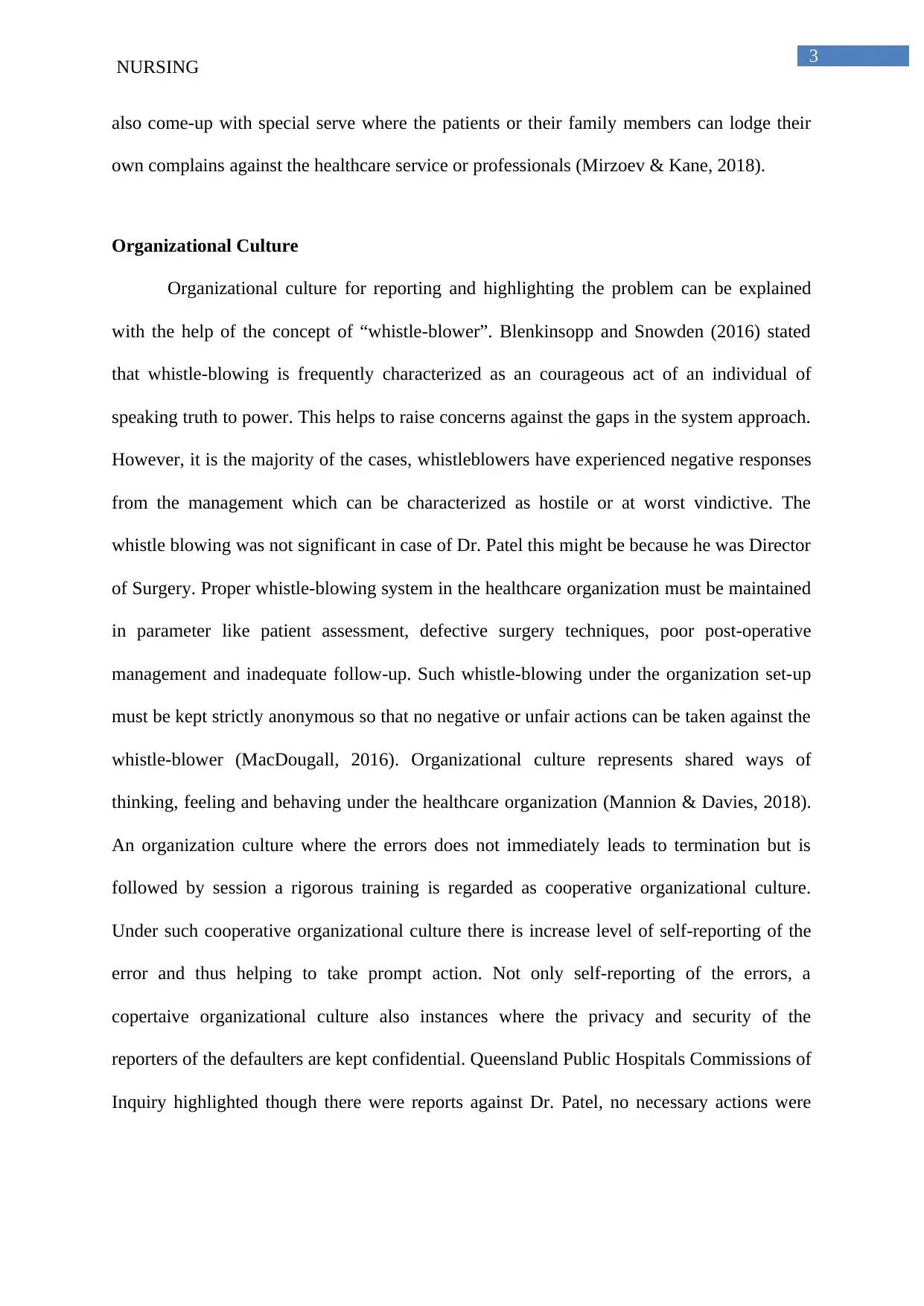
3
NURSING
also come-up with special serve where the patients or their family members can lodge their
own complains against the healthcare service or professionals (Mirzoev & Kane, 2018).
Organizational Culture
Organizational culture for reporting and highlighting the problem can be explained
with the help of the concept of “whistle-blower”. Blenkinsopp and Snowden (2016) stated
that whistle-blowing is frequently characterized as an courageous act of an individual of
speaking truth to power. This helps to raise concerns against the gaps in the system approach.
However, it is the majority of the cases, whistleblowers have experienced negative responses
from the management which can be characterized as hostile or at worst vindictive. The
whistle blowing was not significant in case of Dr. Patel this might be because he was Director
of Surgery. Proper whistle-blowing system in the healthcare organization must be maintained
in parameter like patient assessment, defective surgery techniques, poor post-operative
management and inadequate follow-up. Such whistle-blowing under the organization set-up
must be kept strictly anonymous so that no negative or unfair actions can be taken against the
whistle-blower (MacDougall, 2016). Organizational culture represents shared ways of
thinking, feeling and behaving under the healthcare organization (Mannion & Davies, 2018).
An organization culture where the errors does not immediately leads to termination but is
followed by session a rigorous training is regarded as cooperative organizational culture.
Under such cooperative organizational culture there is increase level of self-reporting of the
error and thus helping to take prompt action. Not only self-reporting of the errors, a
copertaive organizational culture also instances where the privacy and security of the
reporters of the defaulters are kept confidential. Queensland Public Hospitals Commissions of
Inquiry highlighted though there were reports against Dr. Patel, no necessary actions were
NURSING
also come-up with special serve where the patients or their family members can lodge their
own complains against the healthcare service or professionals (Mirzoev & Kane, 2018).
Organizational Culture
Organizational culture for reporting and highlighting the problem can be explained
with the help of the concept of “whistle-blower”. Blenkinsopp and Snowden (2016) stated
that whistle-blowing is frequently characterized as an courageous act of an individual of
speaking truth to power. This helps to raise concerns against the gaps in the system approach.
However, it is the majority of the cases, whistleblowers have experienced negative responses
from the management which can be characterized as hostile or at worst vindictive. The
whistle blowing was not significant in case of Dr. Patel this might be because he was Director
of Surgery. Proper whistle-blowing system in the healthcare organization must be maintained
in parameter like patient assessment, defective surgery techniques, poor post-operative
management and inadequate follow-up. Such whistle-blowing under the organization set-up
must be kept strictly anonymous so that no negative or unfair actions can be taken against the
whistle-blower (MacDougall, 2016). Organizational culture represents shared ways of
thinking, feeling and behaving under the healthcare organization (Mannion & Davies, 2018).
An organization culture where the errors does not immediately leads to termination but is
followed by session a rigorous training is regarded as cooperative organizational culture.
Under such cooperative organizational culture there is increase level of self-reporting of the
error and thus helping to take prompt action. Not only self-reporting of the errors, a
copertaive organizational culture also instances where the privacy and security of the
reporters of the defaulters are kept confidential. Queensland Public Hospitals Commissions of
Inquiry highlighted though there were reports against Dr. Patel, no necessary actions were
Paraphrase This Document
Need a fresh take? Get an instant paraphrase of this document with our AI Paraphraser
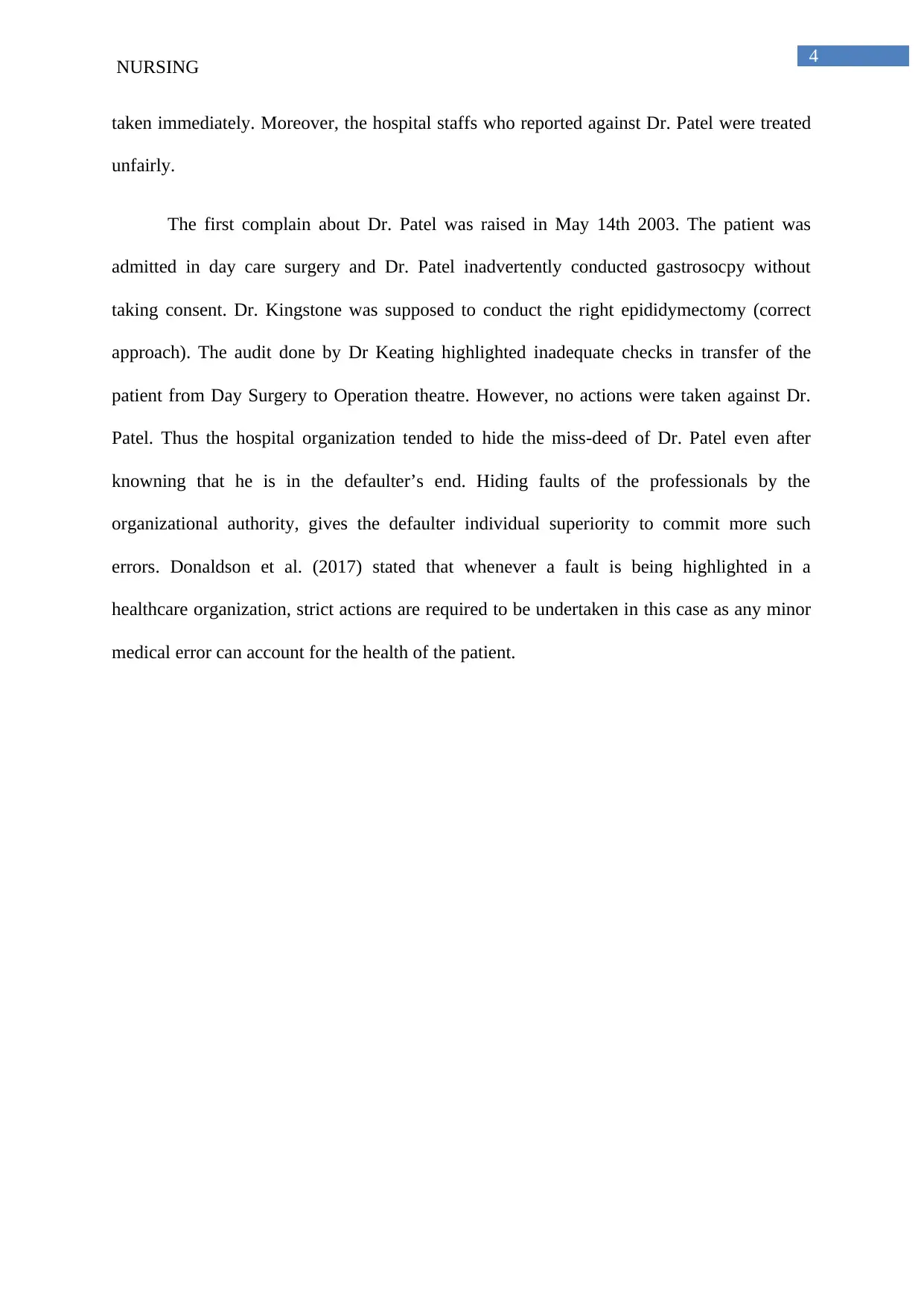
4
NURSING
taken immediately. Moreover, the hospital staffs who reported against Dr. Patel were treated
unfairly.
The first complain about Dr. Patel was raised in May 14th 2003. The patient was
admitted in day care surgery and Dr. Patel inadvertently conducted gastrosocpy without
taking consent. Dr. Kingstone was supposed to conduct the right epididymectomy (correct
approach). The audit done by Dr Keating highlighted inadequate checks in transfer of the
patient from Day Surgery to Operation theatre. However, no actions were taken against Dr.
Patel. Thus the hospital organization tended to hide the miss-deed of Dr. Patel even after
knowning that he is in the defaulter’s end. Hiding faults of the professionals by the
organizational authority, gives the defaulter individual superiority to commit more such
errors. Donaldson et al. (2017) stated that whenever a fault is being highlighted in a
healthcare organization, strict actions are required to be undertaken in this case as any minor
medical error can account for the health of the patient.
NURSING
taken immediately. Moreover, the hospital staffs who reported against Dr. Patel were treated
unfairly.
The first complain about Dr. Patel was raised in May 14th 2003. The patient was
admitted in day care surgery and Dr. Patel inadvertently conducted gastrosocpy without
taking consent. Dr. Kingstone was supposed to conduct the right epididymectomy (correct
approach). The audit done by Dr Keating highlighted inadequate checks in transfer of the
patient from Day Surgery to Operation theatre. However, no actions were taken against Dr.
Patel. Thus the hospital organization tended to hide the miss-deed of Dr. Patel even after
knowning that he is in the defaulter’s end. Hiding faults of the professionals by the
organizational authority, gives the defaulter individual superiority to commit more such
errors. Donaldson et al. (2017) stated that whenever a fault is being highlighted in a
healthcare organization, strict actions are required to be undertaken in this case as any minor
medical error can account for the health of the patient.
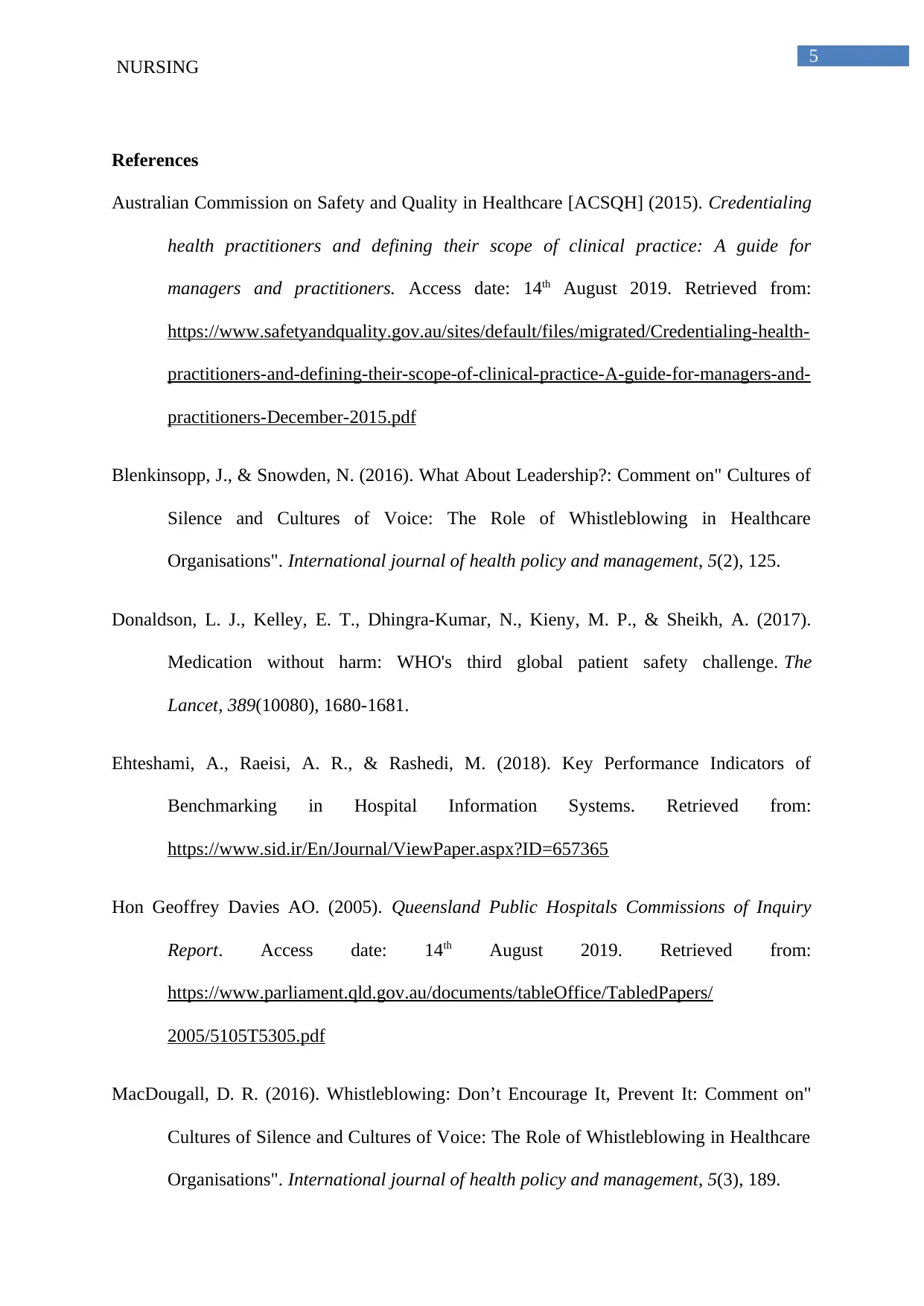
5
NURSING
References
Australian Commission on Safety and Quality in Healthcare [ACSQH] (2015). Credentialing
health practitioners and defining their scope of clinical practice: A guide for
managers and practitioners. Access date: 14th August 2019. Retrieved from:
https://www.safetyandquality.gov.au/sites/default/files/migrated/Credentialing-health-
practitioners-and-defining-their-scope-of-clinical-practice-A-guide-for-managers-and-
practitioners-December-2015.pdf
Blenkinsopp, J., & Snowden, N. (2016). What About Leadership?: Comment on" Cultures of
Silence and Cultures of Voice: The Role of Whistleblowing in Healthcare
Organisations". International journal of health policy and management, 5(2), 125.
Donaldson, L. J., Kelley, E. T., Dhingra-Kumar, N., Kieny, M. P., & Sheikh, A. (2017).
Medication without harm: WHO's third global patient safety challenge. The
Lancet, 389(10080), 1680-1681.
Ehteshami, A., Raeisi, A. R., & Rashedi, M. (2018). Key Performance Indicators of
Benchmarking in Hospital Information Systems. Retrieved from:
https://www.sid.ir/En/Journal/ViewPaper.aspx?ID=657365
Hon Geoffrey Davies AO. (2005). Queensland Public Hospitals Commissions of Inquiry
Report. Access date: 14th August 2019. Retrieved from:
https://www.parliament.qld.gov.au/documents/tableOffice/TabledPapers/
2005/5105T5305.pdf
MacDougall, D. R. (2016). Whistleblowing: Don’t Encourage It, Prevent It: Comment on"
Cultures of Silence and Cultures of Voice: The Role of Whistleblowing in Healthcare
Organisations". International journal of health policy and management, 5(3), 189.
NURSING
References
Australian Commission on Safety and Quality in Healthcare [ACSQH] (2015). Credentialing
health practitioners and defining their scope of clinical practice: A guide for
managers and practitioners. Access date: 14th August 2019. Retrieved from:
https://www.safetyandquality.gov.au/sites/default/files/migrated/Credentialing-health-
practitioners-and-defining-their-scope-of-clinical-practice-A-guide-for-managers-and-
practitioners-December-2015.pdf
Blenkinsopp, J., & Snowden, N. (2016). What About Leadership?: Comment on" Cultures of
Silence and Cultures of Voice: The Role of Whistleblowing in Healthcare
Organisations". International journal of health policy and management, 5(2), 125.
Donaldson, L. J., Kelley, E. T., Dhingra-Kumar, N., Kieny, M. P., & Sheikh, A. (2017).
Medication without harm: WHO's third global patient safety challenge. The
Lancet, 389(10080), 1680-1681.
Ehteshami, A., Raeisi, A. R., & Rashedi, M. (2018). Key Performance Indicators of
Benchmarking in Hospital Information Systems. Retrieved from:
https://www.sid.ir/En/Journal/ViewPaper.aspx?ID=657365
Hon Geoffrey Davies AO. (2005). Queensland Public Hospitals Commissions of Inquiry
Report. Access date: 14th August 2019. Retrieved from:
https://www.parliament.qld.gov.au/documents/tableOffice/TabledPapers/
2005/5105T5305.pdf
MacDougall, D. R. (2016). Whistleblowing: Don’t Encourage It, Prevent It: Comment on"
Cultures of Silence and Cultures of Voice: The Role of Whistleblowing in Healthcare
Organisations". International journal of health policy and management, 5(3), 189.
⊘ This is a preview!⊘
Do you want full access?
Subscribe today to unlock all pages.

Trusted by 1+ million students worldwide
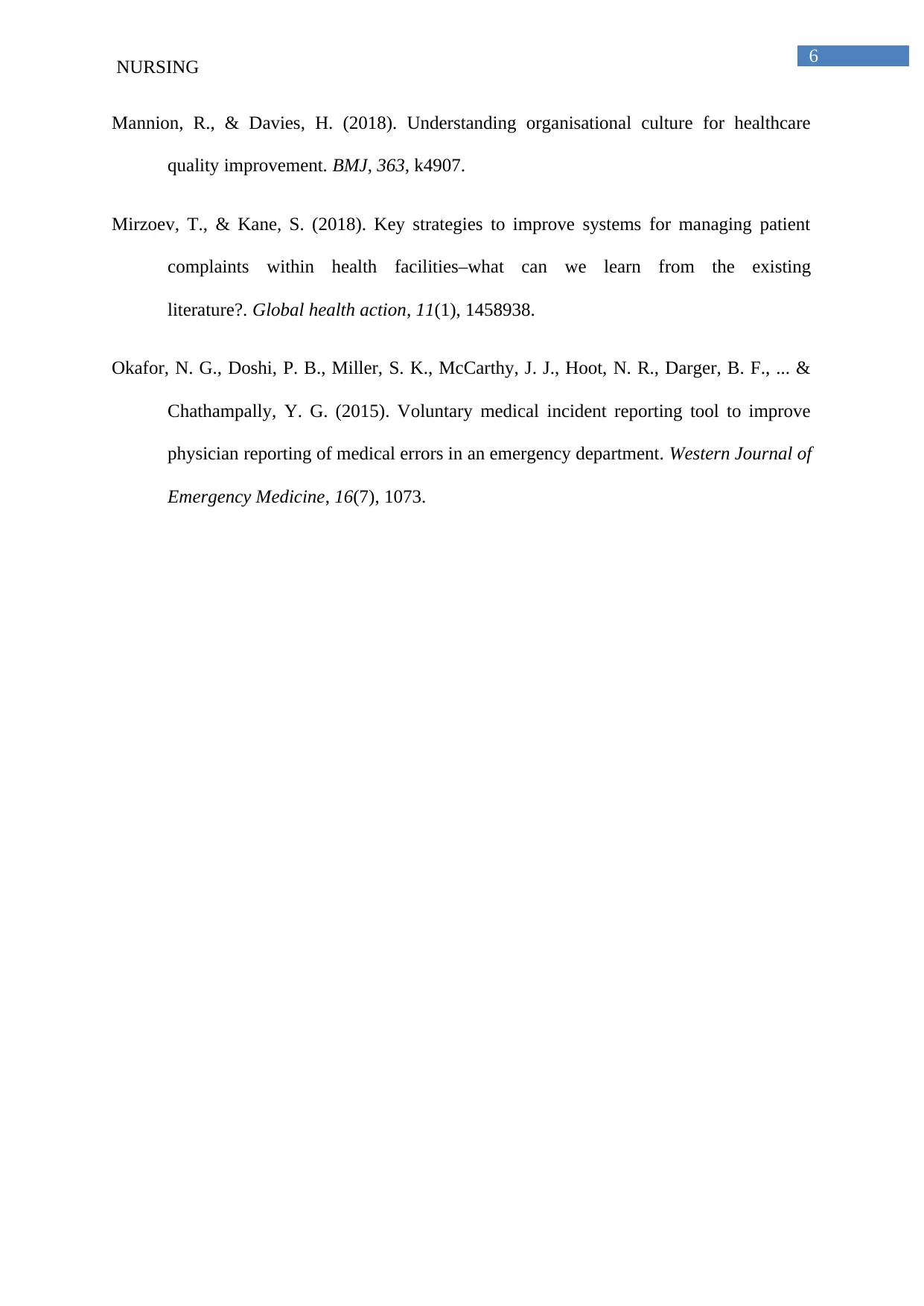
6
NURSING
Mannion, R., & Davies, H. (2018). Understanding organisational culture for healthcare
quality improvement. BMJ, 363, k4907.
Mirzoev, T., & Kane, S. (2018). Key strategies to improve systems for managing patient
complaints within health facilities–what can we learn from the existing
literature?. Global health action, 11(1), 1458938.
Okafor, N. G., Doshi, P. B., Miller, S. K., McCarthy, J. J., Hoot, N. R., Darger, B. F., ... &
Chathampally, Y. G. (2015). Voluntary medical incident reporting tool to improve
physician reporting of medical errors in an emergency department. Western Journal of
Emergency Medicine, 16(7), 1073.
NURSING
Mannion, R., & Davies, H. (2018). Understanding organisational culture for healthcare
quality improvement. BMJ, 363, k4907.
Mirzoev, T., & Kane, S. (2018). Key strategies to improve systems for managing patient
complaints within health facilities–what can we learn from the existing
literature?. Global health action, 11(1), 1458938.
Okafor, N. G., Doshi, P. B., Miller, S. K., McCarthy, J. J., Hoot, N. R., Darger, B. F., ... &
Chathampally, Y. G. (2015). Voluntary medical incident reporting tool to improve
physician reporting of medical errors in an emergency department. Western Journal of
Emergency Medicine, 16(7), 1073.
1 out of 7
Related Documents
Your All-in-One AI-Powered Toolkit for Academic Success.
+13062052269
info@desklib.com
Available 24*7 on WhatsApp / Email
![[object Object]](/_next/static/media/star-bottom.7253800d.svg)
Unlock your academic potential
Copyright © 2020–2025 A2Z Services. All Rights Reserved. Developed and managed by ZUCOL.





